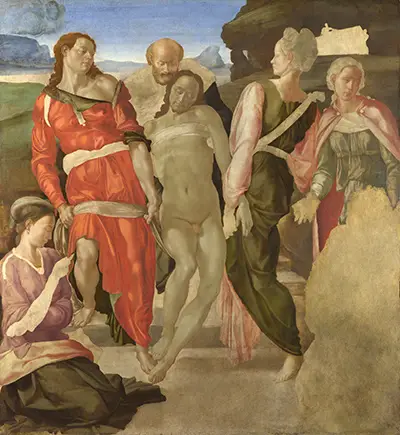This unfinished painting is thought to be the altarpiece that was commissioned from Michelangelo for the church of Sant’Agostino in Rome around 1501. However, it was never delivered and Michelangelo returned the payments he had received.
Perhaps because The Entombment is unfinished, there is no surviving reference to the painting by any of Michelangelo’s contemporaries.
It is not until the 1640s that such a painting is listed in an inventory of the Farnese collection. It is described as a painting by the hand of Michelangelo, showing Christ being carried to his tomb by Mary, St James and Simon of Cyrene.
A later Farnese inventory describes the painting as unfinished and only as “said to be” by Michelangelo. The painting was later part of the collection of Cardinal Fesch, the uncle of Napoleon Bonaparte.
It was in 1846 that the Scottish photographer, artist and art dealer, Robert Macpherson, is said to have stumbled across the work while looking through a group of paintings bought by a dealer at an auction in Rome.
Although the painting was obscured by centuries of dirt, smoke and varnish Macpherson recognised its quality, persuaded the dealer not to sell the piece to a local cabinet-maker, and bought it himself for little more than one pound. In 1868 he sold the work to the National Gallery for £2,000.
The painting shows the dead Christ being carried to the tomb provided by Joseph of Arimathea. The body is being supported by three figures as it is being carried up a flight of steps towards the tomb which was to be painted in the top right of the composition.
There is some doubt as to the identities of the figures surrounding Christ. It is thought that two of the three bearers of the body are most likely to be St John the Evangelist on the left, and Joseph of Arimathea behind.
The third bearer, on Christ’s right, is a tall, rather elongated figure, and is more difficult to identify. It is hard to tell even whether it is a man or a woman. Suggestions for the identity of this figure include Mary Magdalene and Nicodemus the Pharisee and member of the Sanhedrin.
The woman kneeling on the left of the painting has also been identified as Mary Magdalene and the finished painting would have shown her examining the crown of thorns and nails from the cross on which Christ was crucified.
The woman on the right of the painting is thought to be Mary Salome and the unpainted area at the bottom right of the painting would have shown the Virgin Mary had it been finished.
In the centre of the painting, but never quite dominating it, is the body of Christ. Michelangelo has here created an image of the perfect, God-made, man in death.
There has been much speculation as to why the painting was never finished. Some have suggested that Michelangelo would have been dissatisfied with the composition. He might well have considered that the figures surrounding his perfectly rendered pale body of the dead Christ distracted the viewer’s attention away from the painting’s subject and simply decided to abandon the project.
The other possibility is that Michelangelo’s attention was diverted to another, more attractive, commission. It is known that Michelangelo thought of himself as being, primarily, a sculptor, and it is around this time that he was commissioned to produce his Statue of David in Florence.


